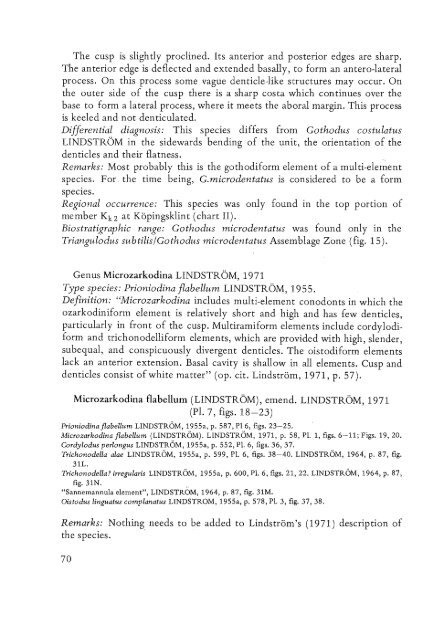UTRECHT MICROPALEONTOLOGICAL BUllETINS
UTRECHT MICROPALEONTOLOGICAL BUllETINS
UTRECHT MICROPALEONTOLOGICAL BUllETINS
Create successful ePaper yourself
Turn your PDF publications into a flip-book with our unique Google optimized e-Paper software.
The cusp is slightly proclined. Its anterior and posterior edges are sharp.<br />
The anterior edge is deflected and extended basally, to form an antero-lateral<br />
process. On this process some vague denticle-like structures may occur. On<br />
the outer side of the cusp there is a sharp costa which continues over the<br />
base to form a lateral process, where it meets the aboral margin. This process<br />
is keeled and not denticulated.<br />
Differential diagnosis: This species differs from Gothodus costulatus<br />
LINDSTROM in the sidewards bending of the unit, the orientation of the<br />
denticles and their flatness.<br />
Remarks: Most probably this is the gothodiform element of a multi-element<br />
species. For the time being, G.microdentatus is considered to be a form<br />
species.<br />
Regional occurrence: This species was only found in the top portion of<br />
member Kk2 at Kopingsklint (chart II).<br />
Biostratigraphic range: Gothodus microdentatus was found only in the<br />
Triangulodus subtilis/Gothodus microdentatus Assemblage Zone (fig. 15).<br />
Genus Microzarkodina LINDSTROM, 1971<br />
Type species: Prioniodina flabellum LINDSTROM, 1955.<br />
Definition: "Microzarkodina includes multi-element conodonts in which the<br />
ozarkodiniform element is relatively short and high and has few denticles,<br />
particularly in front of the cusp. Multiramiform elements include cordylodiform<br />
and trichonodelliform elements, which are provided with high, slender,<br />
subequal, and conspicuously divergent denticles. The oistodiform elements<br />
lack an anterior extension. Basal cavity is shallow in all elements. Cusp and<br />
denticles consist of white matter" (op. cit. Lindstrom, 1971, p. 57).<br />
Microzarkodina flabellum (LINDSTROM), emend. LINDSTROM, 1971<br />
(PI. 7, figs. 18-23)<br />
Prioniodinaflabellum LINDSTROM, 1955a, p. 587, P16, figs. 23-25.<br />
Microzarkodina flabellum (LINDSTROM). LINDSTROM, 1971, p. 58, PI. 1, figs. 6-11; Figs. 19,20.<br />
Cordylodus perlongus LINDSTROM, 1955a, p. 552, PI. 6, figs. 36, 37.<br />
Trichonodella alae LINDSTROM, 1955a, p. 599, PI. 6, figs. 38-40. LINDSTROM, 1964, p. 87, fig.<br />
31L.<br />
Trichonodella? irregularis LINDSTROM, 1955a, p. 600, PI. 6, figs. 21, 22. LINDSTROM, 1964, p. 87,<br />
fig. 31N. ..<br />
"Sannemannula element", LINDSTROM, 1964, p. 87, fig. 31M.<br />
Oistodus linguatus complanatus LINDSTROM, 1955a, p. 578, PI. 3, fig. 37,38.<br />
Remarks: Nothing needs to be added to Lindstrom's (1971) description of<br />
the species. .
















